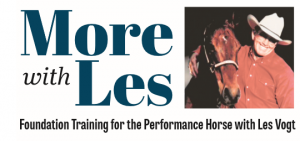 Just like with everything else, there is a program for developing great stops on your horse, and the exercise we call the collected stop is the first phase. This stop exercise is critically important because it is where you begin to teach your horse to stop with the correct form.
Just like with everything else, there is a program for developing great stops on your horse, and the exercise we call the collected stop is the first phase. This stop exercise is critically important because it is where you begin to teach your horse to stop with the correct form.
I think it works so well because when you do it, you’ll be pushing your horse into the stop mode rather than pulling on him. We push the horse by clucking, riding him up with our legs and softening his neck. When he assumes perfect posture, then we can let him stop. He develops great form, and the stop becomes the big reward instead of a punishment or something he starts to dread.
The Collected Stop
So, to do the collected stop, we start at the walk and ride our horse from his back end up to his neck—that means slow him down in the front with our hands, speed him up behind with our legs. And we cluck a little for extra energy. The horse should literally compress like an accordion and get shorter in frame.
Your goal is to make going forward a lot of work for your horse. Make him really step up and put some effort into it. Typically, he would be stopping from the amount of pressure you are using with your hands (make sure you keep your hands moving if you need to—to keep him soft), but you are making him go with your legs. So, when will we let him stop?
When we feel like it. And when will we feel like it? We’ll feel like it when his neck is so soft that it feels like my bridle is hanging on a doorknob or a nail, not in a horse’s mouth. That light. You can stop when he is consistently that soft in your hands—not just for a stride or two.
To let him stop, we’re going to keep our hands moving while we stop driving him with our legs. The result you’re looking for is that he will stop with his back legs underneath him since his back is so round and his poll is soft. It should almost feel like there is a bungee cord attached to the back of your saddle that pulls him down, and he will actually drop at the walk. When a horse stops correctly you can actually see the back of the saddle start to lift as he initiates the stop, because he is rounding his back. You’re not looking for a hard stop here, but for perfect form—neck soft, back round, hind end underneath. A multi-step stop, what we call a “sequence stop,” is fi ne here too as long as everything stays soft and rounded.
–Les
Les Vogt has won more than 15 World Championships, including two wins at the NRCHA Snaffle Bit Futurity. Today Les focuses is giving clinics around the world and developing products for the performance horseman. To learn more about Les and to see his clinic schedule, visit www.lesvogt.com.
Leave a Comment
All fields must be filled in to leave a message.